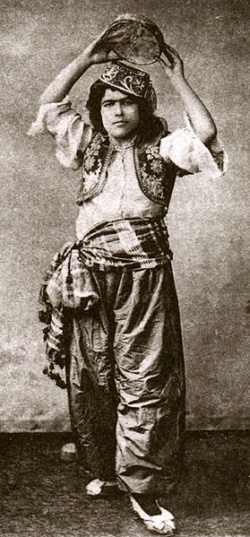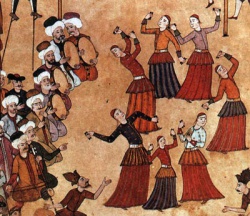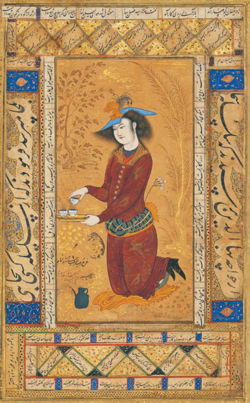Köçek

Entertainers, köçeks were in high demand in the Ottoman Empire. They were sought by high and low, up to the Sultan.
Photograph, late 19th c.
The köçek phenomenon (plural köçekler in Turkish) is one of the significant features of Ottoman Empire culture [Citation needed]. The köçek was typically a very handsome young male rakkas, "dancer," usually cross-dressed in feminine attire, employed as an entertainer.
The köçeks were usually slave children of non-Muslim dhimmi peoples living under Ottoman rule. Their ranks were filled from the ethnic groups - mostly Christians - subdued by the Turkish empire (such as the Circassians, Albanians, Balkan Slavs, Armenians, Jews, Roma-Gypsies, Moldavians and Greeks) since the profession was held to be below the dignity of a Muslim and thus forbidden to Muslim boys.
Roots
The Turkish word is derived from the Persian word kuchak, "little," "small," or "young."[Citation needed]
The culture of the köçek, which flourished from the 17th to the 19th century, had its origin in the customs in Ottoman palaces, and in particular in the harems. Its genres enriched both the music and the dance of the Ottomans.
The support of the Sultans was a key factor in its development, as in the early stages the arts form was confined to palace circles. From there the practice dispersed throughout Anatolia and the Balkans by means of independent troupes.
Culture

A köçek would begin training around the age of seven or eight, and would be considered accomplished after about six years of study and practice. A dancer's career would last as long as he was beardless and retained his youthful appearance. Dancers would get married when they were around 25 or 30, and then could become organizers of a new köçek troupe. Köçeks were organized into companies known as kol. Twelve such companies were counted in the mid-1600s, each company averaging about 250 dancers.
Their erotic dances, collectively known as köçek oyunu, blended Arab, Greek, Assyrian and Kurdish elements. They were performed to a particular genre of music known as köçekce, which was performed in the form of suites in a given melody. It too was a mix of Sufi, Balkan and classical Anatolian influences, some of which survives in popular Turkish music today. The accompaniment included various percussion instruments, such as the davul-köçek, the davul being a large drum, one side covered with goat skin and the other in sheep skin, producing different tones.
A köçek's skill would be judged not only on his dancing abilities but also on his proficiency with percussion instruments, especially a type of castagnette known as the çarpare. In later times these were replaced by metal cymbals called Zils. The dancers were accompanied by an orchestra, featuring four to five each kaba kemence and lauto as principal instruments, used exclusively for köçek suites. There were also two singers. A köçek dance in the Ottoman Seraglio (palace harem) involved one or two dozen köçeks and many musicians. The occasions of their performances were wedding or circumcision celebrations, feasts and festivals, as well as the pleasure of the sultans and the aristocracy.
The youths, often wearing heavy makeup, would curl their hair and wear it in long tresses under a small black or red velvet hat decorated with coins, jewels and gold. Their usual garb consisted of a tiny red embroidered velvet jacket with a gold-embroidered silk shirt, shalvars (baggy trousers), a long skirt and a gilt belt, knotted at the back. They were said to be "sensuous, attractive, effeminate," and their dancing "sexually provocative," impersonating female dancers. Dancers minced and gyrated their hips in slow vertical and horizontal figure-8's, rhythmically snapping their fingers and making suggestive gestures. Often acrobatics, tumbling and mock wrestling were also part of the act. The köçeks were available sexually, often to the highest bidder, in the passive role.
The names and backgrounds of köçeks in Istanbul in the 18th century are well documented. Among the more celebrated köçeks from the end of the 18th century are the Gypsy Benli Ali of Dimetoka (today's Greece); Buyuk (big, older) Afet (born Yorgaki) of Croatian origin, Kucuk (little) Afet (born Kaspar) of Armenian origin, and Pandeli from the Greek Island of Chiros. There were at least fifty köçeks of star stature at the time. The famous ones, like the Gypsy köçek Ismail, would have to be booked weeks or months in advance, at a very high cost.
Western visitors were variously taken with the - for them - unusual sight of pederasty unleashed. One impression is preserved in Don Leon, a poem anonymously written in the voice of Lord Byron:

- Here much I saw – and much I mused to see
- The loosened garb of Eastern luxury.
- I sought the brothel, where, in maiden guise,
- The black-eyed boy his trade unblushing plies;
- Where in lewd dance he acts the scenic show –
- His supple haunches wriggling to and fro:
- With looks voluptuous the thought excites,
- Whilst gazing sit the hoary sybarites:
- Whilst gentle lute and drowsy tambourine
- Add to the languor of the monstrous scene.
- Yes, call it monstrous! but not monstrous, where
- Close latticed harems hide the timid fair:
- With mien gallant where pæderasty smirks,
- And whoredom, felon like, in covert lurks.
- All this I saw – but saw it not alone –
- A friend was with me, and I dared not own
- How much the sight had touched some inward sense,
- Too much for e’en the closest confidence. (441-8).
In his travels to the Levant, Byron had indeed been present at such a dance as described above. His traveling companion, John Cam Hobhouse, relates in his diary that on Saturday, May 19, 1810:
- This day, went with Byron and a party to the wine houses of Galata. Took pipes, and saw two old and ugly boys, who wrung the sweat off their brows, dance as before, waving their long hair. Also they spread a mat and, putting on a kind of shawl, performed an Alexandrian woman’s dance – much the same, except that they knelt, and, covering each other’s heads, seemed as if kissing. One of Mr Adair’s Janissaries, who talks English and has been in England, was with us. I asked him if these boys would not be hanged in England. “Oh yes, directly. De Turk take and byger dem d’ye see?”
- For this beastly sight we paid fifty-five piastres, five to the boys each, and five to all fiddlers and singers and performers &c., nor is this dear, I understand. Turk boys are not allowed to dance. Excerpt from Hobhouse's diary
The youths were held in high esteem. Famous poets, such as Fazyl bin Tahir Enderuni, wrote poems, and classical composers, such as the court musician Hammamizade İsmail Dede Efendi (1778-1846), composed köçekces for celebrated koceks. Many Istanbul meyhanes (night-time taverns serving meze, raki or wine) hired köçeks. Before starting their performance, the köçek danced among the spectators, to make them more excited. In the audience, competition for their attention often caused commotions and altercations. Men would go wild, breaking their glasses, shouting themselves voiceless, or fighting and sometimes killing each other vying for the boys' sexual favors. This resulted in suppression of the practice under sultan Sultan Abd-ul-Mejid I. Köçek dances were officially banned in 1856, and many of the boys left the country to practice their profession in Egypt and elsewhere. With the suppression of harem culture under Sultan `Abdu'l-`Aziz (1861-1876) and Sultan Abdul Hamid II (1876-1908), köçek dance and music lost the support of its royal patrons, and gradually disappeared.
The other type of rakkas, or male dancer (from raks, "dance") was the tavşan oğlan, "rabbit boy," a young dancer dressed in provocative male clothing: tight pants and a jaunty hat. The non-Muslim tavşan oğlan are thought to have come mainly from the Greek islands in the Aegean and the Sea of Marmara. They performed mainly during Ramadan, working as sakis "wine boys" in the meyhanes otherwise, when not dancing at special occasions.
Köçeks were much more sought after than the Çengi, their female counterparts. Some youths were known to have been killed by the Çengi, who were extremely jealous of men's attention towards the boys.
Modern offshoots
At present, the same-sex love and sexuality aspect of köçek culture is considered to have been "a privilege of the powerful economic classes or the world of the arts." Though no new compositions or performances have taken place in the last hundred years, male dancers dressed as women still perform in some areas of Turkey, though their art is no longer primarily of a sensual nature and is seen primarily as folkloric.
The style however continues to inspire modern musicians. Ulvi Cemal Erkin (1906-1972) is a Turkish classical composer whose most popular masterpiece is Köçekçe a dance rhapsody composed in 1943, and perhaps the best known single piece of Turkish music abroad. It was first introduced to the public in 1943 with Ernst Praetorius conducting the Presidential Symphony Orchestra.
The music genre has been preserved in the Balkans in the form of the Čoček, and is especially popular in Kosovo, Albania and the Republic of Macedonia. It is also an important music genre amongst the Roma-Gypsies and is performed at weddings, circumcisions and festivals all over the Balkans.
Another modern interpretation is the movie Kocek (Küçük cadi 1975) by director Nejat Saydam. It is probably the first Turkish movie to deal with the topic of homosexuality and change of gender role. At the same time, young male dancers dressed in sparkling costumes are again finding favor, despite the objections of conservative commentators. Known as rakkas, they have become a common feature of dance halls and night clubs, performing seductive belly dances, and are reputed to be "as sexual and popular as any of the best Turkish female belly dancers."
See also
- Bacchá
- Culture of the Ottoman Empire
- Harem
- Ottoman Turkish language
- Pederasty in the Middle East and Central Asia: Ottoman Empire
- Tellak
- List of transgender-related topics
References
- AYVERDI, Sâmiha; Istanbul Geceleri The nights of Istanbul, ed. Baha, Istanbul, 1977.
- ENDERUNLU Fazıl bey; Çenginame', 1759
- Erdoğan, Sema Nilgün: Sexual life in Ottoman Empire, ed. Dönence, Istanbul, 1996. Pp 88–92
- JANSSEN, Thijs: Transvestites and Transsexuals in Turkey, in Sexuality and Eroticism Among Males in Moslem Societies, edited by Arno Schmidt and Jehoeda Sofer, ed. Harrington Park Press, NY, 1992
- KOCU, Resad Ekrem, Eski Istanbul'da Meyhaneler ve Meyhane Kocekleri, Istanbul Ansiklopedisi Notlari No
- OZTUNA, Yılmaz: Turk Musikisi Ansiklopedisi, Milli Egitim Basimevi, Istanbul, 1976. p. 23